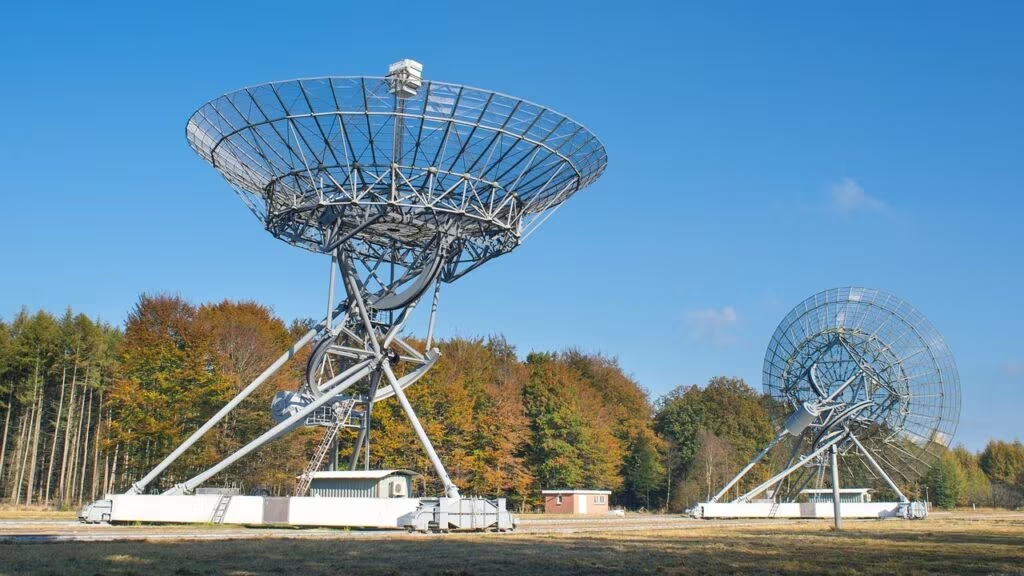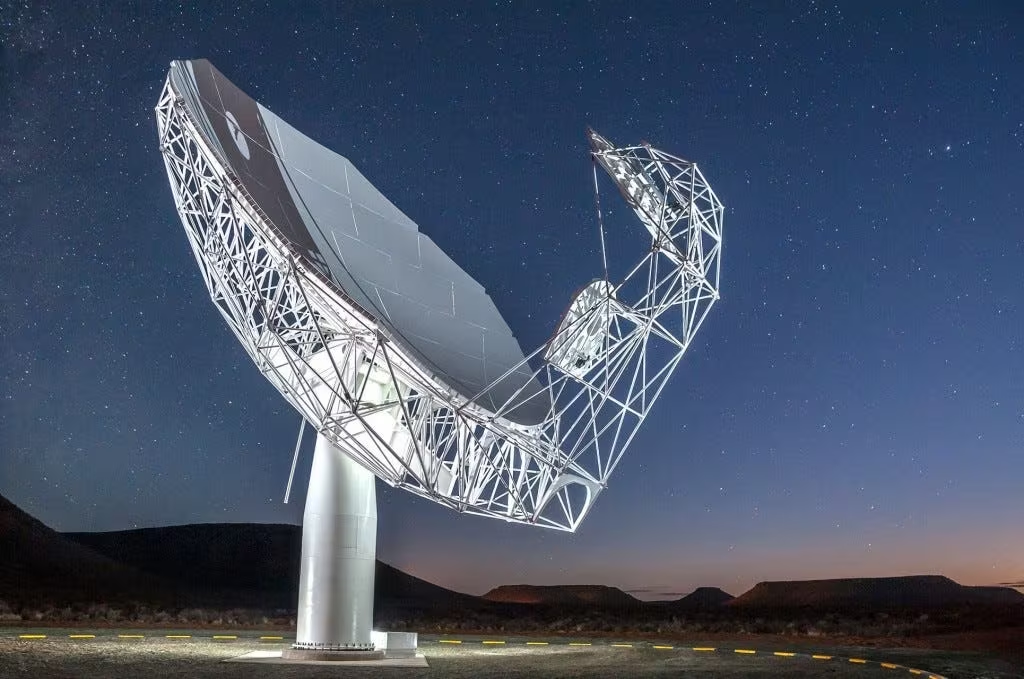The Interstellar Radio Mystery: Interpreting Signals from 3I/ATLAS

The detection of any signal originating from an interstellar object—a visitor from beyond our solar system—immediately captures global attention. When the MeerKAT Radio Telescope in South Africa registered a radio signal potentially linked to the third identified interstellar object, designated 3I/ATLAS, the scientific community faced a critical challenge: distinguishing between natural cosmic phenomena and potential technosignatures.
Harvard Professor Avi Loeb, a leading figure in the search for extraterrestrial intelligence (SETI) and the study of interstellar objects like ‘Oumuamua, analyzed the data. His focus centered not on the strength of the emission, but on a crucial spectral fingerprint: absorption by hydroxyl radicals (OH molecules). This analysis provides a vital lesson in astrophysical interpretation, demonstrating how common interstellar chemistry can mimic or mask more exotic possibilities.
MeerKAT’s Observation and the Context of 3I/ATLAS
MeerKAT, an array of 64 dishes, each 13.5 meters in diameter, is renowned for its high sensitivity and ability to map large areas of the sky. The observation in question involved tracking the trajectory of 3I/ATLAS, an object believed to be the third confirmed interstellar visitor to pass through our solar system, following 1I/’Oumuamua and 2I/Borisov.
Loeb’s analysis focused on a specific radio frequency detected in the direction of the object. While the initial detection sparked interest, the subsequent spectroscopic analysis revealed a distinct pattern of absorption. This pattern is key to understanding the object’s environment and composition.
The Scientific Diagnostic: Hydroxyl Radical Absorption
The core of the scientific interpretation rests on the behavior of the hydroxyl radical (OH). The hydroxyl radical is a simple molecule consisting of one oxygen atom and one hydrogen atom. It is ubiquitous in the cosmos, found in molecular clouds, cometary comae, and the atmospheres of certain stars.
Why OH Molecules Matter in Radio Astronomy
OH molecules possess specific energy transitions that occur at radio wavelengths, primarily around 18 centimeters. These transitions allow the molecules to either absorb or emit radio waves at precise frequencies (e.g., 1612 MHz, 1665 MHz, 1667 MHz, and 1720 MHz). The presence of OH absorption in the signal associated with 3I/ATLAS is a powerful diagnostic tool, pointing strongly toward a natural, cometary origin for the object.
Key Interpretations of OH Absorption:
- Cometary Outgassing: The presence of OH radicals is a definitive indicator of water ice sublimation. When an icy body, like a comet, approaches the sun, the ice turns directly into gas (sublimes). Water molecules ($ ext{H}_2 ext{O}$) are then broken down by solar ultraviolet radiation into hydrogen ($ ext{H}$) and hydroxyl ($ ext{OH}$). The resulting cloud of gas, known as the coma, absorbs background radio emissions.
- Natural Origin Confirmation: The clear spectral signature of OH absorption provides a strong natural explanation for the observed radio phenomena, suggesting that 3I/ATLAS is likely a large, icy body—an interstellar comet—rather than an artificial structure.
- Distance and Environment: The depth and width of the absorption lines can provide information about the density and temperature of the gas cloud surrounding 3I/ATLAS, helping astronomers model its composition and activity level as it traverses the solar system.
“The detection of hydroxyl radical absorption is a classic signature of water-rich cometary activity. While the initial excitement of a radio signal from an interstellar object is understandable, the spectroscopic evidence quickly guides us toward a natural, chemical explanation,” Professor Loeb noted in his analysis.
The Challenge of Technosignature Interpretation
Professor Loeb’s work often emphasizes the need to exhaust all natural explanations before considering an artificial origin (a technosignature). The case of 3I/ATLAS provides a perfect example of this rigorous scientific methodology.
When a radio signal is detected near an anomalous object, the possibilities range from mundane terrestrial interference to extraordinary extraterrestrial technology. The presence of OH absorption serves as a crucial filter, eliminating the need to invoke non-natural explanations for the observed radio characteristics.

Differentiating Signals
For a signal to be considered a viable technosignature candidate, it would ideally possess characteristics that are difficult or impossible to explain through known astrophysics, such as:
- Narrowband Emission: Extremely narrow frequency bandwidths, which are characteristic of artificial transmissions, not natural sources like stars or molecular clouds.
- Pulsed or Modulated Patterns: Non-random, repetitive, or structured patterns that suggest encoding or intentional communication.
- Frequency Stability: Maintaining a precise frequency over time, compensating for Doppler shifts caused by the object’s motion.
- Absence of Natural Tracers: A signal that is strong and artificial-looking, yet lacks the accompanying spectral signatures of common astrophysical processes (like OH, $ ext{CO}$, or $ ext{H}_2 ext{O}$).
In the case of 3I/ATLAS, the OH absorption signature confirms that the radio wave interaction is governed by the object’s natural, water-rich chemistry, effectively closing the door on the technosignature hypothesis for this specific observation.
Broader Implications for the Galileo Project
This analysis reinforces the methodology employed by the Galileo Project, which Professor Loeb chairs. The project aims to systematically search for evidence of extraterrestrial technological artifacts, both in space and potentially on Earth.
The lesson learned from 3I/ATLAS is that the search for technosignatures must be paired with an equally rigorous understanding of natural astrophysical phenomena. Every anomalous signal must first be subjected to the most stringent tests of known physics and chemistry.
This process ensures that resources are focused on truly unexplained anomalies, rather than being diverted by misinterpretations of common cosmic chemistry. The ability of instruments like MeerKAT to provide high-resolution spectral data—not just simple detections—is paramount to this effort.
Future Interstellar Object Searches
As astronomical surveys like the Vera C. Rubin Observatory come fully online, the rate of discovery for interstellar objects is expected to increase dramatically. Astronomers anticipate finding dozens, if not hundreds, of these visitors in the coming years. Each new object will present a fresh opportunity for radio observation and analysis.
- Enhanced Sensitivity: Future radio telescopes will need even greater sensitivity to detect faint signals, both natural and artificial.
- Rapid Follow-up: The transient nature of interstellar objects requires immediate, multi-wavelength follow-up observations to gather crucial data before they exit the solar system.
- Spectral Analysis: Detailed spectroscopic analysis, focusing on molecular tracers like OH, will remain the primary method for classifying these objects as natural comets, asteroids, or something entirely new.
Key Takeaways: 3I/ATLAS and Radio Interpretation
The analysis of the radio signal associated with 3I/ATLAS, focusing on the absorption by hydroxyl radicals, provides a clear scientific conclusion and a roadmap for future interstellar object studies.
- Natural Explanation Confirmed: The presence of hydroxyl radical (OH) absorption strongly indicates that 3I/ATLAS is an active, water-rich interstellar comet undergoing outgassing.
- MeerKAT’s Role: The MeerKAT Radio Telescope demonstrated its capability to not only detect faint radio sources but also to provide the necessary spectral resolution for detailed chemical analysis.
- Scientific Rigor: Professor Loeb’s analysis underscores the necessity of ruling out all natural astrophysical explanations, such as cometary chemistry, before considering the possibility of a technosignature.
- Interstellar Object Classification: The OH signature is a crucial tool for classifying interstellar visitors, helping astronomers understand the distribution and composition of material originating from other star systems.
This event serves as a powerful reminder that while the search for extraterrestrial technology is vital, the universe is filled with complex, natural chemistry that often presents itself in intriguing ways, demanding careful and expert interpretation.
Original author: Avi Loeb
Originally published: November 8, 2025
Editorial note: Our team reviewed and enhanced this coverage with AI-assisted tools and human editing to add helpful context while preserving verified facts and quotations from the original source.
We encourage you to consult the publisher above for the complete report and to reach out if you spot inaccuracies or compliance concerns.

